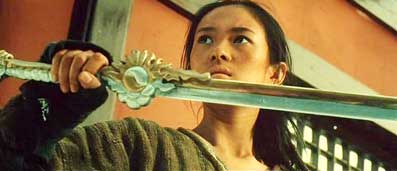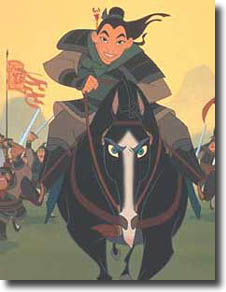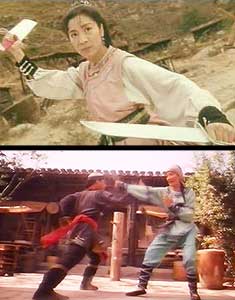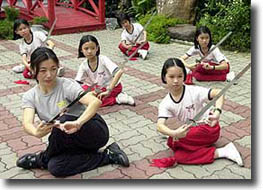
| Home | |||
| About Us | |||
| Overview | |||
| History | |||
| Culture | |||
| Philosophy | |||
| Practice | |||
| References | |||
| Shaolin | |||
| Hsing Yi | |||
| Tai Chi | |||
| Bagua | |||
| Baji | |||
| Health | |||
| Other Styles | |||
|
|
|||
| Links | |||
| Directory | |||
| News | |||
n interesting and important aspect of Chinese Martial Arts is the contribution of women to its evolution and development. Despite being a predominately male activity, the martial arts have attracted some remarkable female contributors. Their involvement re-emphasizes the point that the practice of traditional Chinese Martial Arts depends on mind, will, and spirit, and that physical strength is less important.
The romantic notions of woman skilled in the martial arts exist in fiction as well as reality. Their contribution can be seen today.
The following are some of the prominent female martial artists in history:
Yu Niu (770 BC - 221 AD)
When fencing, though highly alert
The appearance is as calm as a fair lady's
But when in action, a vicious Tiger emerges
---------
Weak and exposed in appearance;
But powerful when unleashed.
One's reactions may start afterwards,
But the response arrives there first.
ccording to ancient Chinese history, Yu Niu was the best swordsman of her period. During the "Spring and Autumn" periods (770 BC - 221 AD), the King of the Zhou kingdom organized a sword contest. Yu Niu was chosen as the victor over three thousand swordsmen in the seven-day contest. Her sword methods and philosophies are still recognized today.
Baogu (317-420)
aogu, named Qianguang, lived during the Eastern lin Dynasty (AD 317-420). Her father, Bao Qian, was a commander in southern Guangdong province and a Taoist who studied the Qi Huang Plan (a famous medical treatise). When she was twenty years old, her father arranged for her to marry his close friend and fellow Taoist, the famous chemist and doctor, Ge Hong. She travelled with her husband through southern Yue (Guangdong province), "plucking and testing one hundred herbs, finding cures for strange diseases, saving countless lives". Baogu's medical skills were superb, especially in the field of moxibustion. Acupuncture and moxibustion are the traditional Chinese methods of treating illnesses. Baogu and Ge Hong worked together on their first treatise to emphasize the theories of moxibustion; the Zhouhou Beiji Fang.
Princess Ming-Lian (467)
rincess Ming-Lian was the daughter of Emperor Liang Wu Di. She became the only female disciple of Damo. For her devotion, the emperor built a temple so that other woman could also worship Buddha. The temple was near the Shaolin Temple, but was built facing west as a sign of respect to the Buddha. During her path towards enlightenment, Princess Ming-lian also studied Chi Kung, the martial arts, and herbal medicine.
Other famous women followed along the path of Princess Ming-lian and became the leader of the Temple. Yongtai, the Princess of Beiwei Dynasty, was the successor to Princess Ming-lian. Princess Yongtai was well known for helping people. There are many stories locally about how she helped people and achieved high status in her qigong and martial arts practice. In her memory, the name of the temple was changed from Ming-lian Temple to Yongtai Temple - the name it still bears today. This temple produced many nuns renown for their ability to cure people with herbs. This Buddhist temple for women is little known by most Chinese, let alone the world. .
Mulan (589-618 CE)
|
I
want to buy a saddle and horse, |
|
Ode
of Mulan
Anonymous (c.5 A.D.) |
ulan is a well-known heroine in Chinese history and now in the West thanks to the Disney movie "Mulan". The real story of Mulan is lost in time, but she is remembered in a well-known Chinese poem, written during the Northern Dynasties (AD 420-589), and later turned into a novel, during the late Ming Dynasty (AD 1368-1644), and then into a play, during the Qing Dynasty. To this day, her real name is not known. According to the Annals of the Ming, her surname was Zhu, while the Annals of the Qing say it was Wei. A play by Xu Wei gives her the surname Hua (Flower), but that could be literary licence. Others, using The Ballad of Mulan as their guide, have attributed the surname Mu to her.
Disney introduced Mulan to the West with great success. The legend, the novel and the play all describe the plight of a young girl, Mulan, who lived in Northern China. In one of the many wars against foreign invaders, Mulan disguised herself as a man to serve in the army in her father's place. She was an able and courageous warrior, and won many battles. The emperor recognized her for her accomplishments and offered her many rewards including a government position. She turned down all her rewards in favour of going home and living a peaceful life with her family. After she returned home, she changed back into her old clothes. When she reappeared as a girl, not one of her friends recognized her even though they had fought side by side for many years.
The story of Mulan inspired many generations of Chinese woman because of its Confucius morality (honouring the father, protecting the country) and elements of Taoist thinking (inaction, leaving government office for the family). Its influence can still be felt today.
Ying Meifeng from Shanghai created Mulan Quan as a tribute to the ideals of this character. Established less than ten years ago, this form of martial art is based on hua jia quan - an ancient martial art featuring dance moves. Mulan quan consist of six sets with 52 to 82 moves in each set. Some of the sets involve the use of a single sword, single fan, double swords or double fans. Because of its health benefits, this exercise has attracted tens of thousands of followers all over China, in Japan, Southeast Asia, Europe and America.
Ng Mui and Yim Wing Chun (1662-1722)
Yuen Wo Ping's 1994 movie Wing Chun, starring Michelle Yeoh, depicts the fictional life of the martial artist.
uring the Ching Dynasty (1662-1722), the emperor K'anghsi felt that the Shaolin temple could resist the rule of the Ching government. He ordered its destruction. Ng Mui, the head nun at an affiliate Temple, was one of the few people that escaped the massacre. She retreated to the White Crane Temple on Mt. Tai Leung (also known as Mt. Chai Har). Her knowledge and skills of the martial arts was legendary.
Yim Wing Chun was a native of Canton [Kwangtung Province] in China. She married Leung Bok Chau, a salt merchant of Fukien. They finally settled at the foot of Tai Leung Mountain near the border between Yunan and Szechuan provinces. She encountered Ng Mui and studied with her for many years. Under Ng Mui, Wing Chun developed a style that is extremely efficient and ideally suited to smaller fighters having less strength. Wing Chun then taught her skills to her husband Leung Bok Chau. Leung then trained Wong Wah Bo (an opera performer). Wong Wah Bo taught Leung Yeu Tei. Leung Yeu Tei moved to Fat Shan, Southern China One of his students in Fat Shan was Leung Jan. Leung Jan taught his skills to Chan Wah Shan. Yip man, a noted Wing Chun fighter before becoming famous as the teacher of Bruce Lee, is the student of Chan Wah Shan.
Present Day
Teaching a new generation of students to carry on the tradition of Chinese Martial Arts.
ociety has changed, and so has role of women. Slowly, their contribution and importance in all areas are being recorded and noticed. Women are now recognized for their interest in and contribution to the martial arts. During our research on the web, we have come across many female martial artists who are today actively training and promoting Traditional Chinese Martial Arts. We are extremely interested in expanding our knowledge of and friendship with others in the martial art community. So let us know if you know of other examples of female martial artists.
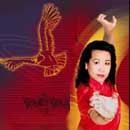 |
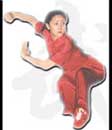 |
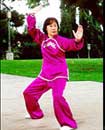 |
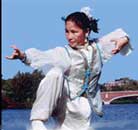 |
Copyright 2003
